Two successes of private astronautics
Last week there were two rather important events for private astronautics. First of all, the two pilots of the Virgin Galactic can drill holes in their suits under the icons of astronauts - having risen to Dec. 82 to 82.7 km, SpaceShipTwo was above the 50-mile line, which determines astronauts by American criteria. And Rocket Lab managed to send Electron into the flight just a month after the previous launch, which confirms the feasibility of their plans to launch their missiles often.
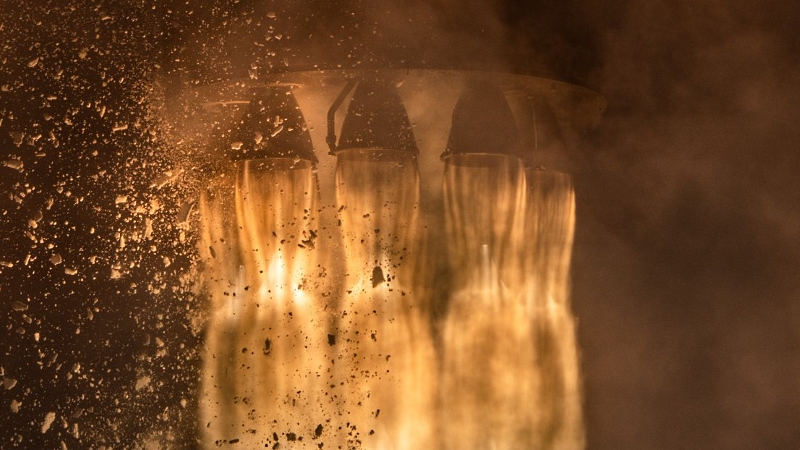
Launch of Electron launch vehicle, photo by Brady Kenniston
On December 13, the next tests of the SpaceShipTwo suborbital tourist spaceplane took place. This was the fifteenth flight of the second unit in the series (the first one crashed in 2014). Four flights were conducted in 2016 without disconnecting the SS2 from the carrier aircraft. Then 7 tests were planned without the inclusion of a rocket engine. And in 2018 we had 4 flights with the engine turned on and a gradual increase in the maximum height reached: 25.7 km in April, 34.9 in May, 52 km in July and 82.7 now. Now only one step is left before the Virgin Galactic - a flight for the full duration of the engine and rise above 100 km. The device will not go into orbit, but it will give passengers a few minutes of real weightlessness with the ability to take selfies against the background of approximately this type of window.
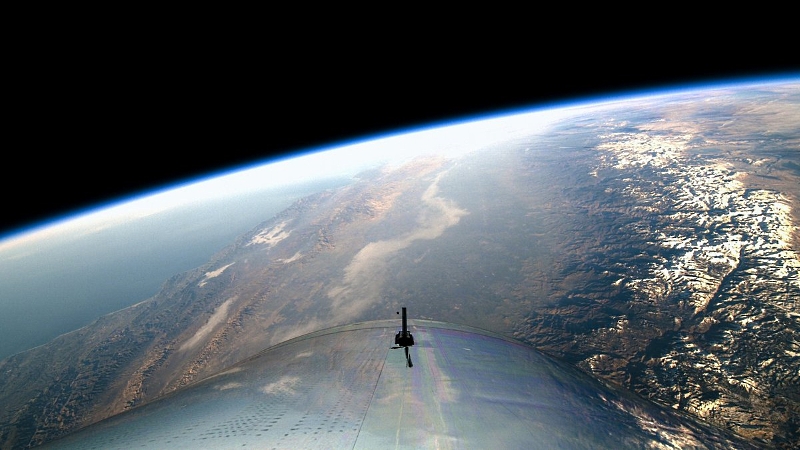
')
SpaceShipTwo was piloted by two people, Frederick Sterkow and Mark Stuck. Sterkou - an experienced astronaut and pilot, flew more than 6 thousand hours on 60 types of aircraft and made four space missions on the Space Shuttle. Knocks had never been in space before, but flew more than 9 thousand hours on nearly two hundred types of aircraft. Now they both rightly get the "wings" of commercial astronauts, becoming the third and fourth in the list. The first two places belong to Mike Melville and Brian Binnie, who piloted SpaceShipOne suborbital space planes in 2004. Let me remind you, then SpaceShipOne won the Ansari X Prize, twice within two weeks by launching a manned spacecraft above 100 km. The fact that now SpaceShipTwo did not reach 100 km, in this case, it does not matter, because according to the American rules an astronaut is a person who has risen above 50 miles, and 82.7 km in miles is 51.4. Successful tests have already generated a wave of congratulations, because for the United States this is the first manned flight from its territory after the shutdown of the shuttles. Virgin Galactic was also congratulated by US Vice President Mike Pence and NASA CEO Jim Brandenstein. There is a slight irony in the fact that suborbital spacecraft overtake space - the first soft landing of a reusable first stage rocket that rises above 100 km is New Shepard, not Falcon 9, and now Virgin Galactic formally began to produce astronauts before Boeing and SpaceX.
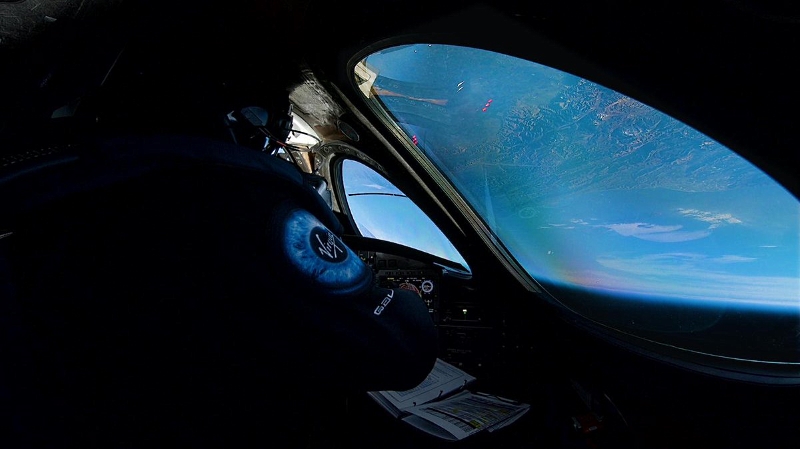
Image of Virgin Galactic
The joy is so great that Richard Branson, in his speech, preferred to “forget” SpaceShipOne and called this flight "the first ever case when a manned ship built for the commercial transport of passengers reached space." This, alas, is incorrect - SpaceShipOne could lift one pilot and two passengers into space, and if not for billionaire Paul Allen’s desire to transfer it to the museum, the first space tourists could go on a suborbital flight back in 2004.
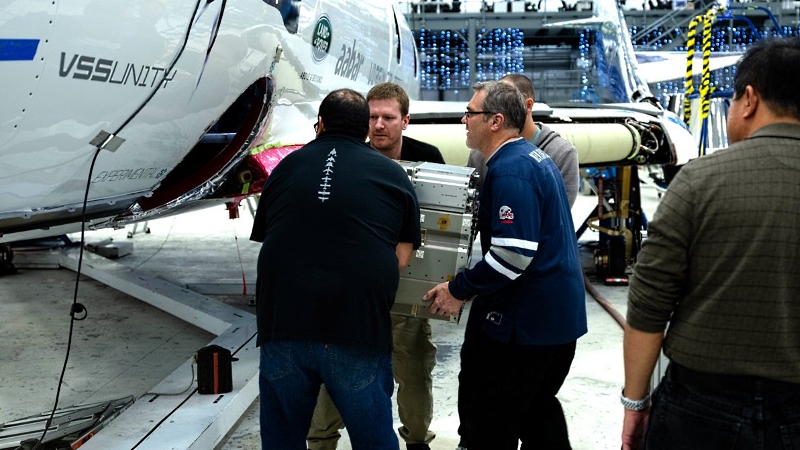
Image of Virgin Galactic
Curiously, SpaceShipTwo began to take on scientific cargo. At New Shepard, the associated loads have been carried for a long time, but for SpaceShipTwo this experience was the first. Four experiments set off the flight - COLLIDE (already flying New Shepard 2016), studying collisions with dust in vacuum, an experiment studying the behavior of liquids and gases in weightlessness, an experiment with plants in weightlessness, and an experimental platform isolating the payload from the vibrations of the carrier vehicle flew on New Shepard this summer).
Shortly before landing, the SS2 performed a barrel, a symbolic gesture similar to the circle of honor among athletes.
According to the head of the Virgin Galactic Richard Branson, the next flight could take place somewhere in a month. Ideally, before the start of commercial operation, only three more tests will be required. SpaceShipTwo so far took the lead in the suborbital race - Blue Origin planned to start manned flights in 2018, but, according to the latest news, the plans moved to 2019. It is interesting that very different technical systems are competing. SpaceShipTwo is a winged vehicle that rises into the air on a carrier aircraft, accelerates on a hybrid rocket engine (solid fuel, liquid oxidizer), is controlled by a person throughout the flight, returning, it brakes by turning tail beams that turn the device into a kind of badminton shuttlecock, and landing on an airplane. New Shepard is a combination of a rocket stage and a habitable capsule, starts from a ground launch structure, uses a liquid-propellant rocket engine on oxygen and hydrogen, is controlled by automation and lands separately - a rocket on engines, a capsule on parachutes with soft landing engines.
On the official channel of Virgin Galactic, the videos have not yet been uploaded, so we are watching a compilation from Twitter.
And on Sunday, the fourth launch of the ultra-light Electron launch vehicle took place. After lengthy ordeals with “It's time to do business,” the new rocket flew away just from the second attempt. The first launch window opened on December 13, but the launch was postponed due to the weather. The meteorological forecast promised that the next couple of days would only get worse, so the second attempt was immediately moved to 16. This time there were no problems - the rocket started, illuminated by the sun, and successfully put 13 cubic meters of NASA ELANa into orbit.

Photo by Trevor Mahlmann
Rocket Lab maintains the tradition of the ironic names of its missiles. After "This is a test", "Still testing" and "It's time to do business" in space went "This is for Pickering." Sir William Pickering was born in New Zealand, led the group that created Explorer 1, the first American satellite, and headed NASA's Jet Propulsion Laboratory.
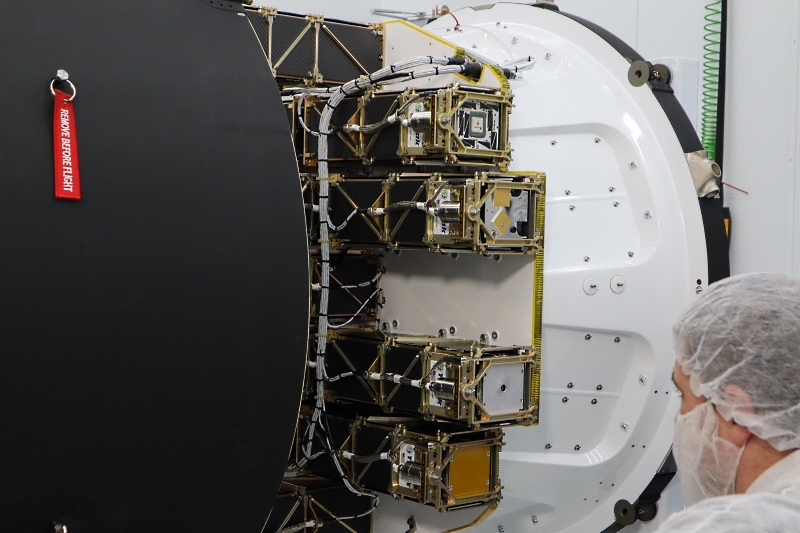
ELaNa-19 satellites
ELaNa - Educational Launch of Nanosatellites ("Educational Nanosatellite Launches") - NASA's program for orbiting nanosatellites for educational purposes. Roscosmos, by the way, has a similar one - it is ready to launch student satellites for free. In the framework of ELaNa, more than fifty satellites, mainly from universities, went into orbit. It is curious that on the NASA website in the nineteenth mission, 10 satellites are listed, and 13 went on the flight, but for nanosatellite trivia, this is normal. The main thing is that illegal devices do not leak (there was already a precedent in the spring). Known total mass of the payload - 78 kg. And the most interesting are CubeSail (two cubsats deployed between a solar sail 250 m long) and RSat-P (a prototype of a repairman satellite with two manipulators printed on a 3D printer). As in previous missions, the satellites are launched into a circular polar orbit with an altitude of 500 km.

RSat-P, US Naval Academy image
On Twitter, Rocket Lab showed a photo of the third-stage section (or upper stage) of the Curie, which turns on at the top of the trajectory at an altitude of 500 km and turns the orbit into a circular one.
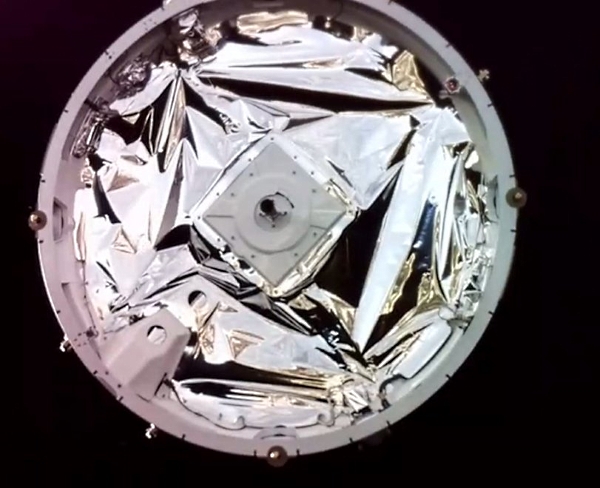
Image Rocket Lab
In general, judging by the video that opens the broadcast, the Rocket Lab is putting cameras in abundance on the rocket, and on the booster blocks, I think they will also delight us with beautiful frames.
Video broadcast.
As many as 11 Electron launches are scheduled for the year 2019, so it will be curious to see if Rocket Lab will manage to realize these ambitious plans.

Launch of Electron launch vehicle, photo by Brady Kenniston
Flight SpaceShipTwo
On December 13, the next tests of the SpaceShipTwo suborbital tourist spaceplane took place. This was the fifteenth flight of the second unit in the series (the first one crashed in 2014). Four flights were conducted in 2016 without disconnecting the SS2 from the carrier aircraft. Then 7 tests were planned without the inclusion of a rocket engine. And in 2018 we had 4 flights with the engine turned on and a gradual increase in the maximum height reached: 25.7 km in April, 34.9 in May, 52 km in July and 82.7 now. Now only one step is left before the Virgin Galactic - a flight for the full duration of the engine and rise above 100 km. The device will not go into orbit, but it will give passengers a few minutes of real weightlessness with the ability to take selfies against the background of approximately this type of window.

')
SpaceShipTwo was piloted by two people, Frederick Sterkow and Mark Stuck. Sterkou - an experienced astronaut and pilot, flew more than 6 thousand hours on 60 types of aircraft and made four space missions on the Space Shuttle. Knocks had never been in space before, but flew more than 9 thousand hours on nearly two hundred types of aircraft. Now they both rightly get the "wings" of commercial astronauts, becoming the third and fourth in the list. The first two places belong to Mike Melville and Brian Binnie, who piloted SpaceShipOne suborbital space planes in 2004. Let me remind you, then SpaceShipOne won the Ansari X Prize, twice within two weeks by launching a manned spacecraft above 100 km. The fact that now SpaceShipTwo did not reach 100 km, in this case, it does not matter, because according to the American rules an astronaut is a person who has risen above 50 miles, and 82.7 km in miles is 51.4. Successful tests have already generated a wave of congratulations, because for the United States this is the first manned flight from its territory after the shutdown of the shuttles. Virgin Galactic was also congratulated by US Vice President Mike Pence and NASA CEO Jim Brandenstein. There is a slight irony in the fact that suborbital spacecraft overtake space - the first soft landing of a reusable first stage rocket that rises above 100 km is New Shepard, not Falcon 9, and now Virgin Galactic formally began to produce astronauts before Boeing and SpaceX.

Image of Virgin Galactic
The joy is so great that Richard Branson, in his speech, preferred to “forget” SpaceShipOne and called this flight "the first ever case when a manned ship built for the commercial transport of passengers reached space." This, alas, is incorrect - SpaceShipOne could lift one pilot and two passengers into space, and if not for billionaire Paul Allen’s desire to transfer it to the museum, the first space tourists could go on a suborbital flight back in 2004.

Image of Virgin Galactic
Curiously, SpaceShipTwo began to take on scientific cargo. At New Shepard, the associated loads have been carried for a long time, but for SpaceShipTwo this experience was the first. Four experiments set off the flight - COLLIDE (already flying New Shepard 2016), studying collisions with dust in vacuum, an experiment studying the behavior of liquids and gases in weightlessness, an experiment with plants in weightlessness, and an experimental platform isolating the payload from the vibrations of the carrier vehicle flew on New Shepard this summer).
Shortly before landing, the SS2 performed a barrel, a symbolic gesture similar to the circle of honor among athletes.
According to the head of the Virgin Galactic Richard Branson, the next flight could take place somewhere in a month. Ideally, before the start of commercial operation, only three more tests will be required. SpaceShipTwo so far took the lead in the suborbital race - Blue Origin planned to start manned flights in 2018, but, according to the latest news, the plans moved to 2019. It is interesting that very different technical systems are competing. SpaceShipTwo is a winged vehicle that rises into the air on a carrier aircraft, accelerates on a hybrid rocket engine (solid fuel, liquid oxidizer), is controlled by a person throughout the flight, returning, it brakes by turning tail beams that turn the device into a kind of badminton shuttlecock, and landing on an airplane. New Shepard is a combination of a rocket stage and a habitable capsule, starts from a ground launch structure, uses a liquid-propellant rocket engine on oxygen and hydrogen, is controlled by automation and lands separately - a rocket on engines, a capsule on parachutes with soft landing engines.
On the official channel of Virgin Galactic, the videos have not yet been uploaded, so we are watching a compilation from Twitter.
Electron
And on Sunday, the fourth launch of the ultra-light Electron launch vehicle took place. After lengthy ordeals with “It's time to do business,” the new rocket flew away just from the second attempt. The first launch window opened on December 13, but the launch was postponed due to the weather. The meteorological forecast promised that the next couple of days would only get worse, so the second attempt was immediately moved to 16. This time there were no problems - the rocket started, illuminated by the sun, and successfully put 13 cubic meters of NASA ELANa into orbit.

Photo by Trevor Mahlmann
Rocket Lab maintains the tradition of the ironic names of its missiles. After "This is a test", "Still testing" and "It's time to do business" in space went "This is for Pickering." Sir William Pickering was born in New Zealand, led the group that created Explorer 1, the first American satellite, and headed NASA's Jet Propulsion Laboratory.

ELaNa-19 satellites
ELaNa - Educational Launch of Nanosatellites ("Educational Nanosatellite Launches") - NASA's program for orbiting nanosatellites for educational purposes. Roscosmos, by the way, has a similar one - it is ready to launch student satellites for free. In the framework of ELaNa, more than fifty satellites, mainly from universities, went into orbit. It is curious that on the NASA website in the nineteenth mission, 10 satellites are listed, and 13 went on the flight, but for nanosatellite trivia, this is normal. The main thing is that illegal devices do not leak (there was already a precedent in the spring). Known total mass of the payload - 78 kg. And the most interesting are CubeSail (two cubsats deployed between a solar sail 250 m long) and RSat-P (a prototype of a repairman satellite with two manipulators printed on a 3D printer). As in previous missions, the satellites are launched into a circular polar orbit with an altitude of 500 km.

RSat-P, US Naval Academy image
On Twitter, Rocket Lab showed a photo of the third-stage section (or upper stage) of the Curie, which turns on at the top of the trajectory at an altitude of 500 km and turns the orbit into a circular one.

Image Rocket Lab
In general, judging by the video that opens the broadcast, the Rocket Lab is putting cameras in abundance on the rocket, and on the booster blocks, I think they will also delight us with beautiful frames.
Video broadcast.
As many as 11 Electron launches are scheduled for the year 2019, so it will be curious to see if Rocket Lab will manage to realize these ambitious plans.
Source: https://habr.com/ru/post/433344/
All Articles